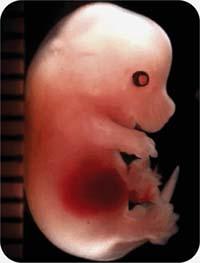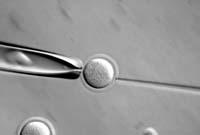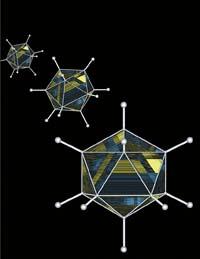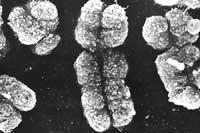Looking for new ways to obtain stem cells
2007/07/01 Elhuyar Zientzia Iturria: Elhuyar aldizkaria

Despite great expectations, researchers have many limitations and difficulties in getting and working with stem cells. But they do not give up, and the research they have published lately is proof of that effort.
For example, researchers at the University of Kyoto have managed to convert adult cells of mice into embryonic cells through a simple mechanism. The embryonic cells obtained are pluripotent, that is, they have the capacity to transform into many types of cells, fully compatible with the donor of the adult cell.
To do this, four transcription factors are introduced through viruses in cells. These factors make cells reprogrammed and acquire the characteristics of pluripotent embryonic cells. Even if it's simple, it can't be said to be a successful process: reprogramming only goes well on one out of every thousand cells.
On the other hand, the integration of pluripotent cells into the mouse embryos has shown that the mice that are born, among their cells, have descendants of the grafted ones, and have also managed to cross these mice with common mice. However, 20% of these tumors.
In addition, in tests with human cells, the results have been even more negative. In humans reprogramming is more complex than in mice, so researchers believe that more factors will be needed. However, many experts believe it will not be enough with it. Therefore, there is still much to come to the height of what achieved in the mouse.

However, in certain cases, it seems that with human cells, better results can be obtained than with mice. This is what at least researchers who are reprogramming defective embryos believe. In fact, in the mouse the first phases of the development of the embryo are extremely fast, much faster than in the human being, which facilitates the control of some steps in the human embryos.
Precisely, researchers at Harvard University try to take advantage of the defective embryos that occur in artificial fertilisation in stem cell research. In artificial fertilisation it is relatively frequent that two spermatozoa simultaneously fertilize one ovum. This embryo is not viable and they discard it.
However, Harvard researchers use these achratic embryos to remove the genetic information they contain and to introduce the genome of an adult cell. The cells of this embryo contain, therefore, genetic information of the adult, but have characteristics of stem cells, are pluripotent. This mechanism prevents women from having to provide research eggs.
Research has been conducted with mouse embryos, but, as mentioned above, it is thought to be easier in humans. In any case, it will not be so simple and, undoubtedly, you will still have to investigate a lot to obtain good results.

Gai honi buruzko eduki gehiago
Elhuyarrek garatutako teknologia





